- Izu Peninsula top
- General
- Earthquake and volcano
- Too many deer in Izu
- East
- Ito - its old buildings
- Anjin = Wlliam Adams and Ito
- Religious Charisma Nichiren
- Washtub race
- Yokikan - Spa ryokan
- Minami-Kaikisen: Auberge
- Ike and its paddy fields
- Summer has come!!!
- Inatori - fish, spa and more
- Central
- Banjo Waterfall
- Mount Amagi
- Shuzenji - old spa town
- Arabashiri - Bandai-Jozo
- Oomi Land - heart of Izu
- West and south
- Heda on the west coast
- Toi - Gold mine
- Matsuzaki - namako wall
- Izu-no-Chohachi - Plasterer
- Kumomi on the west coast
- Shimoda - Tojin-Okichi
- Cottage life
- Fishing in Usami
- Start of my fishing life
- Training camp in Amagi
- Cottage life / music&drinks
- Party in Izu - part 2
- Party in Izu - part 1
- Sunday morning concert
- Ice and snow in Amagi
- My summer house
- Restaurant and eatery
- Let’s eat Izu-Deer!
- Isui-an - exquisite soba
- Sugizen - big prawn fry
- Sayang - Bali restaurant
- Restaurant Tanaka

Heda seen from Goze-observatory. Heda Bay is protected by a narrow sandbank from wild weather. Two museums and a shrine are located on the bank.
Heda on the west coast- Deep-sea fish and Russian connection
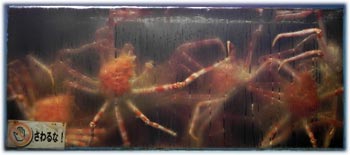
Takaashi-gani in the glass tank of a restaurant
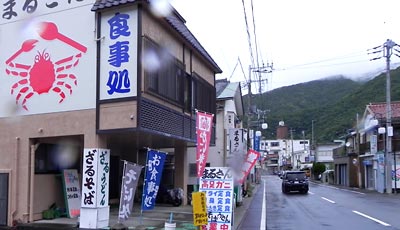
A restaurant in the main streeto of Heda
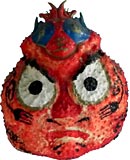
A mask using Tkaashi-gani shell
There is a museum in Heda displaying the deep-sea fishes of Suruga Bay and we can see there exotic and weird fishes from the depth of the Bay. Next to it there is another small museum: Museum of Shipbuilding Materials Collected from Local Areas. The lengthy name unfortunately does not tell us much about its exhibits. The main part of its collection consists of the materials related to the Russian ship Diana and the building of the first European style ship in Japan.
Diana was the ship used by Russian Rear Admiral Yevfimy Putjatin when he came to Japan with a view to conclude a treaty. He arrived in Japan in 1953, only a month later than the American Commodore Perry. After the first contact with the Shogun government, he changed his ship for a newly built Diana. While Putjatin was negotiating with the Japanese side in 1854 in Shimoda (a town on the south coast of Izu) Diana was severely damaged at its bottom and rudder by the tsunami caused by a heavy earthquake.
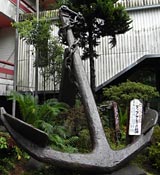 The original anchor of Diana |
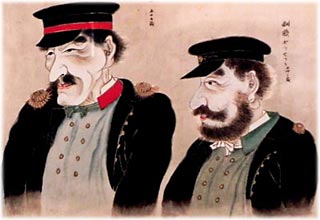
Putjatin and his aid depicted by a Japanese painter
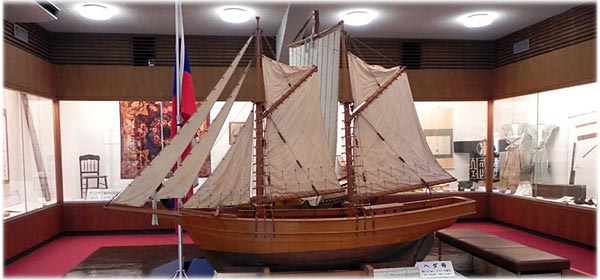
A 1/10 model of Heda displayed in the museum. There are some materials from Diana and the original plan of Heda in the showcase.
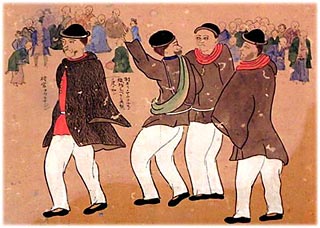
Russian sailors and Japanese onlookers
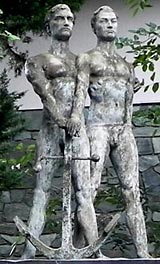 Japan - Soviet Union friendship monument erected in 1965 |
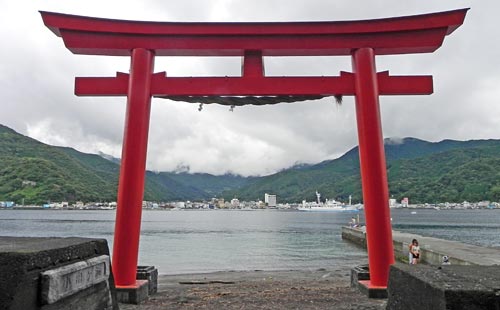
Heda seen through the torii of Morokuchi-Shrine next to the museums
 By the way, Putjatin agreed with the Japanese side on the border between the islands Urup and Iturup. Unfortunately the islands south of Iturup are occupied by the Russians after WWII and Japan has been trying to recover them in vain.
By the way, Putjatin agreed with the Japanese side on the border between the islands Urup and Iturup. Unfortunately the islands south of Iturup are occupied by the Russians after WWII and Japan has been trying to recover them in vain.The friendship between the family Putjatin and Russia on the one hand and Heda on the other lasts till today. In 1887 Putjatin's daughter Oliga Putyatina visited Heda and donated on her death 100 Ruble to Heda. A stone monument was built by the donation. Later in 1965 when this museum was built, five million yen was donated by the then Soviet Government and a model of Diana, which was displayed at the Osaka Expo in 1970, was also donated to the museum after the exhibition.